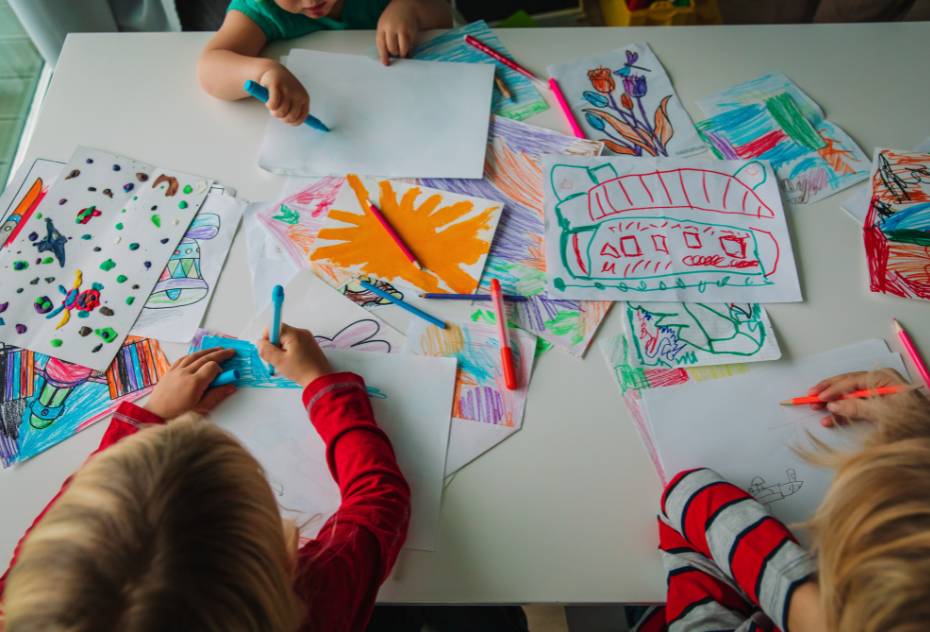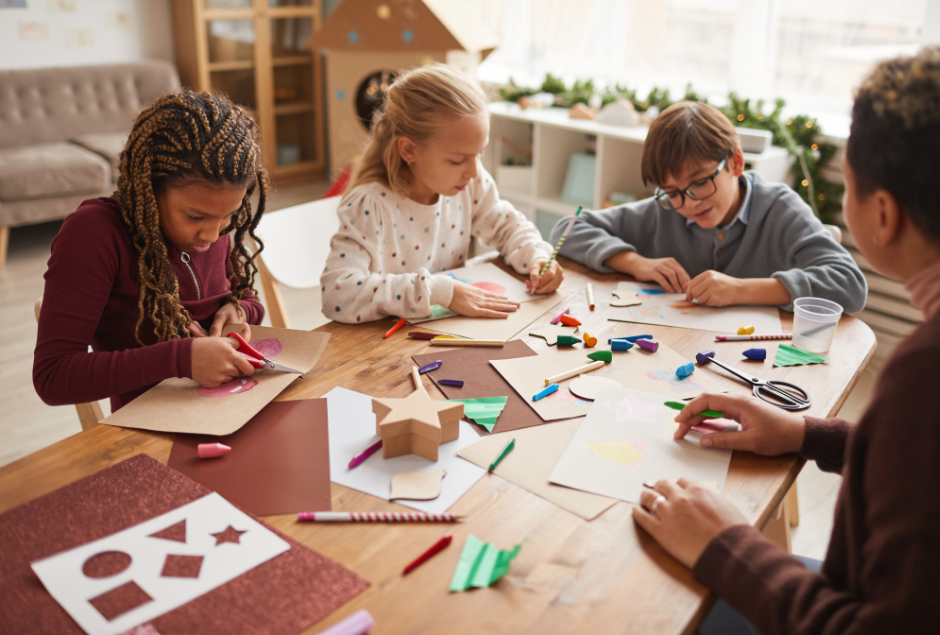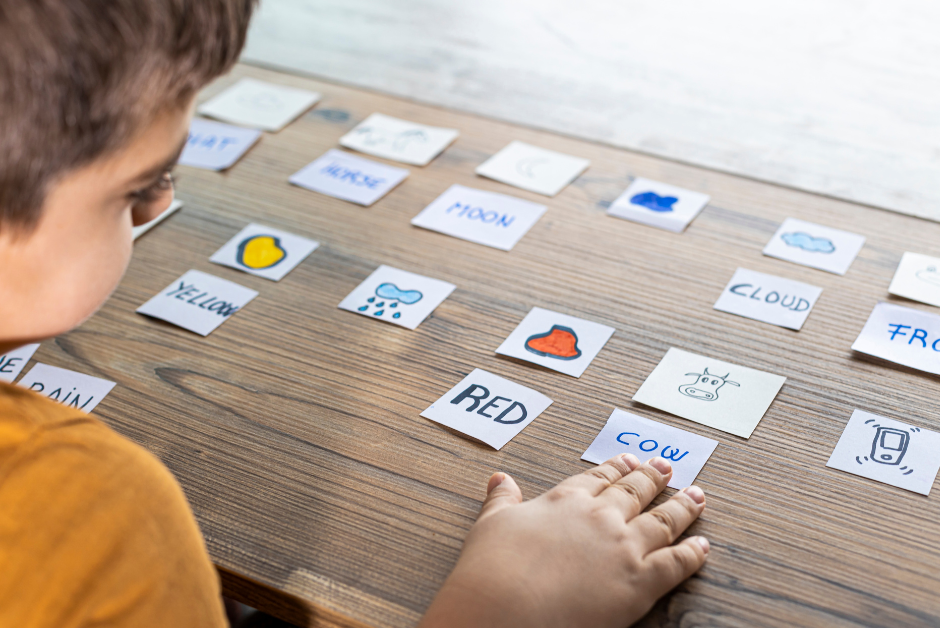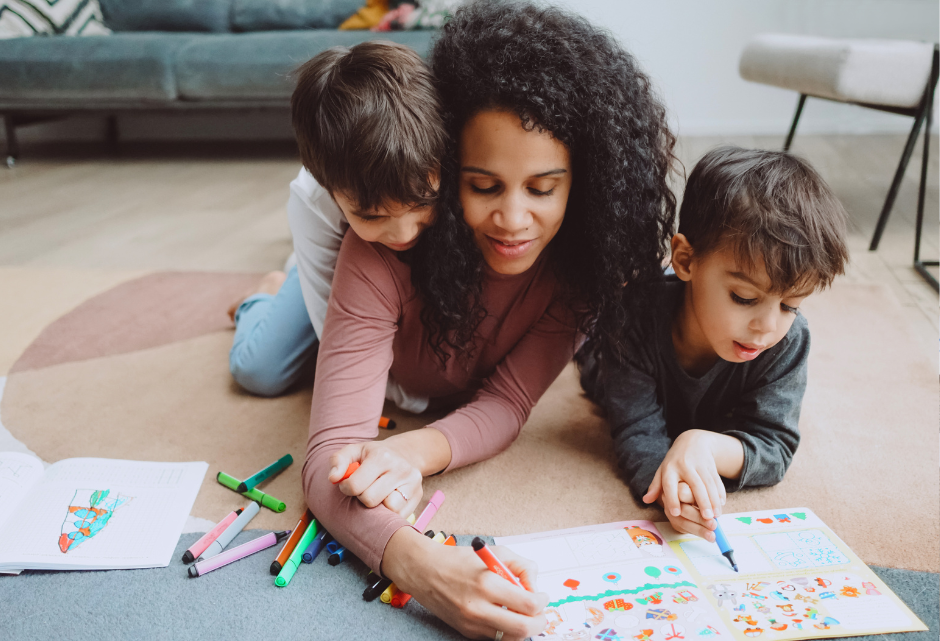Hello! Today, I want to talk about how to learn English in a fun way through art. Art, using colors and shapes to express what’s inside our hearts, actually brings significant benefits to learning English.
The Benefits of Learning Language Through Art

Art transcends words in communication. By drawing or molding clay, children express their feelings and thoughts. This process offers a great opportunity to naturally learn and use new vocabulary.
Benefit 1: Learning New Words
During art activities, words related to colors, shapes, and actions naturally come up. Starting with simple words like “red,” “circle,” “cut,” and “paste,” children can gradually challenge more complex expressions.
Benefit 2: Improved Communication Skills
Through art, children get more opportunities to explain the thoughts and feelings behind their work. This naturally enhances their ability to speak in English. Moreover, discussions with friends and teachers also strengthen their listening skills.
Benefit 3: Development of Creativity and Expressiveness
Art maximizes an individual’s imagination. As children express their world through their creations, their expressiveness in English also enriches. Explaining in English, such as “This is a spaceship,” goes beyond mere word learning to more profound expression.
Benefit 4: Learning While Having Fun
The most important thing is that art activities are fun. When learning feels enjoyable, it naturally motivates children to use English more. Learning becomes play, and play becomes learning, creating a wonderful cycle.
Recommended Art Activities Using English
Learning English through art is one of the best methods for children to learn while having fun. How can we incorporate art activities to learn English from the basics? In this section, we introduce simple activities that can be tried at home or in the classroom.
Art Activity 1: Learning About Colors and Shapes
Colors and shapes are fundamental elements of art and also the first steps in learning English. For example, using simple instructions like “draw a red square” or “a blue circle,” children can learn words related to colors and shapes naturally.

Art Activity 2: Storytelling Art
Children draw their favorite stories or ones they’ve imagined. After finishing their drawings, they explain them in English. This activity not only enhances vocabulary but also helps in understanding grammatical structures. Using expressions like “There is a…” and “It is…” helps you naturally learn the basics of English grammar.
Art Activity 3: English Labeling
Labeling art pieces or favorite drawings in English. For example, naming objects or people in the drawings or explaining what the scene depicts in English stickers. This method is highly effective in understanding words and their usage.
Art Activity 4: Projects Using Crafts
Through craft projects, children learn English by doing. For instance, directing projects in English like “Let’s make paper flowers” or “Animal masks” allows learning materials and procedural words related to English. It also teaches verbs and prepositions.
Art Activity 5: Games Through Art
Playing games like “I spy with my little eye…” using children’s artwork. This activity allows you to train listening and vocabulary skills simultaneously. Plus, it’s a fun way to practice English listening and speaking.
Recommended Crafts Using English
Art and crafts are wonderful tools for making English learning more fun. Here, we introduce several art & craft ideas that children can enjoy while learning English. These projects can be easily tried at home or in the classroom, nurturing both creativity and language skills.
Craft Activity 1: Create Colorful Word Cards
Word cards are very helpful in learning new vocabulary. Have children draw and write new words they are learning in English. For example, animals, fruits, vegetables, vehicles, etc. These cards can be used for various games and activities.

Craft Activity 2: Keeping a Diary in English
Provide children with small sketchbooks to record daily events and feelings with drawings and English words. This activity aids in memorizing expressions used in daily conversations. Drawing also helps better remember the day’s events.
Craft Activity 3: Themed Art Projects
Choose themes like “marine life,” “space,” “our home,” etc., and create art works related to these themes. Through the project, learn English vocabulary related to the theme. Children can use the newly learned words to explain their works in English.
Craft Activity 4: Create an English Recipe Book
Cooking is a form of art. Have children write simple recipes in English and then cook according to them. This activity is perfect for learning imperative sentences and vocabulary related to ingredients and cooking methods. Furthermore, take photos of the finished dishes and compile them with the recipes into a small book.
Craft Activity 5: Interactive Story Books
Encourage children to come up with their own stories and turn them into picture books. In these stories, they write simple sentences in English and accompany them with illustrations. This project promotes creative writing and vocabulary learning through storytelling. Having the completed books read by family and friends gives children confidence in using English.
Home Art Projects Made Easy
Art projects that make learning English more enjoyable can easily be done at home. Here, we present ideas for art projects that don’t require special materials and can be enjoyed using items found around the house. These activities stimulate children’s creativity and aid in their English learning.
Project 1: Daily Themes to Learn Colors and Shapes
Set a different theme for each day and create art based on that theme, such as “Day of the Sea,” “Space Exploration Day,” “Zoo Day,” etc. Create a list of related words in English, and encourage children to use these words to draw or craft according to the theme. At the end of the project, encourage them to briefly describe their work in English.
Project 2: Craft Time with English Quizzes
Before starting an art project, give related English quizzes. For example, quizzes about colors, shapes, animals, or objects related to the project. Learning through quizzes before engaging in the project provides an opportunity to touch on English from the beginning. Make the quiz fun for children by incorporating a points system, and prepare a small reward at the end of the project.
Project 3: Step-by-Step Instructions in English
Give all project instructions in English. Explain the instructions in simple English, incorporating visuals (pictures or photos) to aid understanding. This way, children listen to English while engaging in hands-on learning. Additionally, include small English mini-quizzes or rhythm games in each step of the project for fun learning.
Project 4: Creating Art with English Songs and Rhythms
Play English songs or incorporate rhythm games while doing art projects. For example, draw to the rhythm of an English song or read an English poem that fits the project theme. Music and rhythm are memorable, so they are a fun way to remember English phrases.
Project 5: Keeping an English Art Diary with Parents
Record the outcomes of art projects in an English diary. Paste photos of the day’s art creations and write in English about what was learned or felt about the project. Through this activity, children reflect on the project while naturally practicing English expressions.

Learning Expressiveness in English Through Art
The expressiveness developed through learning English via art involves several elements and skills, including:
1. Rich Vocabulary
Engaging in art activities in English helps one naturally acquire a wide range of vocabularies related to colors, shapes, techniques, emotions, etc. As children describe their artwork, they learn new words and use them to express their opinions and feelings.
2. Descriptive and Explanatory Skills
Explaining the meaning behind art pieces or the process of creation in detail develops the ability to express concrete situations and abstract concepts in words. This forms the foundation for accurate and rich expressiveness in English.
3. Creative Expressiveness
Through art, children form images of their inner world or imaginary worlds. Describing these in English fosters the ability to express creative ideas in the language. Using poetic or metaphorical expressions expands the linguistic range.
4. Communication Skills
Exchanging opinions about art pieces or presenting their own works enhances all four English language skills: listening, speaking, reading, and writing. Especially, explaining or critiquing their own works cultivates the ability to convey thoughts clearly.
5. Critical Thinking Skills
Analyzing art pieces or reflecting on their own creations develops the ability to think critically and express those thoughts in English. This includes the ability to view things from different perspectives and logically construct one’s opinions.
The expressiveness gained through art and English learning encompasses more than merely memorizing words. The skills developed in art activities lay the foundation for children to express themselves and communicate with the world in English. Through these activities, children understand the power of words and gain confidence in sharing their thoughts and feelings in English.
Conclusion: Enriching English Learning Through Art
Learning English through art is a wonderful way for children not only to learn new words but also to use the language to express their world. The art projects and activities introduced here naturally extend vocabulary and expressive skills while also nurturing creativity and critical thinking.
Rediscovering the Charm of English Learning Through Art
Through art activities, children transition from learning English to using it. As they draw or craft, they naturally find opportunities to use English, making the learning process more enjoyable and meaningful. Moreover, art teaches the importance of experimenting without fear of mistakes, an attitude that’s equally vital in language learning.
Enhancing Expressive and Communication Skills
Projects and activities involving art enrich children’s expressive skills and their ability to convey thoughts and emotions in English. Narrating stories through art or keeping an art diary of daily events allows children to practice expressing more complex ideas and feelings in English, directly linking to improved communication skills.
Motivation in English Learning
The most crucial aspect of learning English through art is the strong motivation it provides for children. When learning is fun and creative, children are more eager to engage with new words and expressions, showing more enthusiasm towards learning. Enjoying the learning process is key to retaining knowledge long-term.
Quality Time for Family Learning

Art projects offer an ideal opportunity for family involvement in learning, serving as a shared educational time. This shared time not only supports children’s learning but also integrates English into family communication as a natural tool.
In conclusion, enriching English learning through art is a significant investment in children’s future. By integrating these activities, children not only learn a language but also discover new ways to view the world and express themselves. This journey of learning English through art promises a deeper understanding and confidence in using the language, fostering a lifelong appreciation for both art and English.



